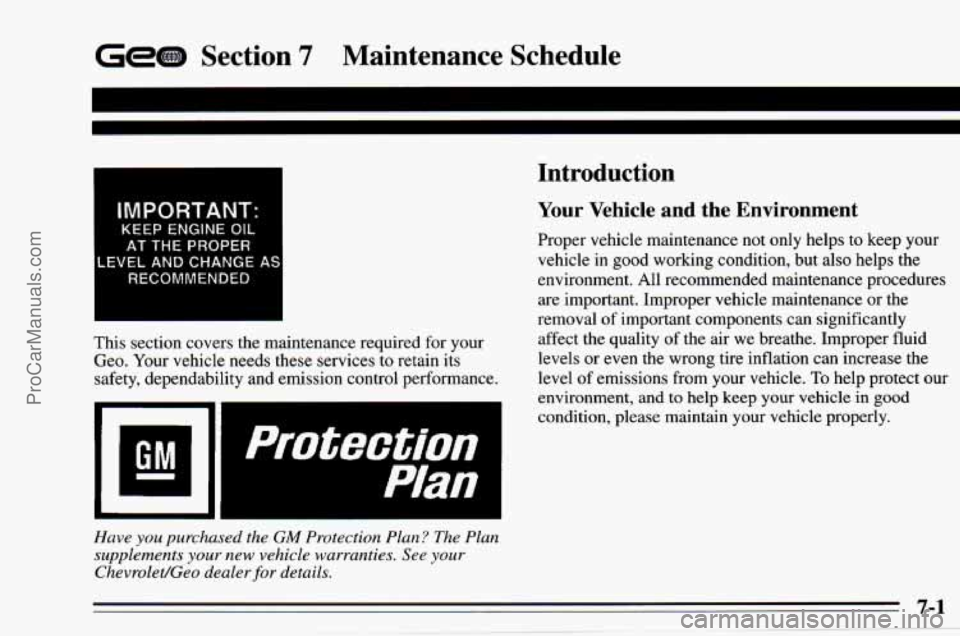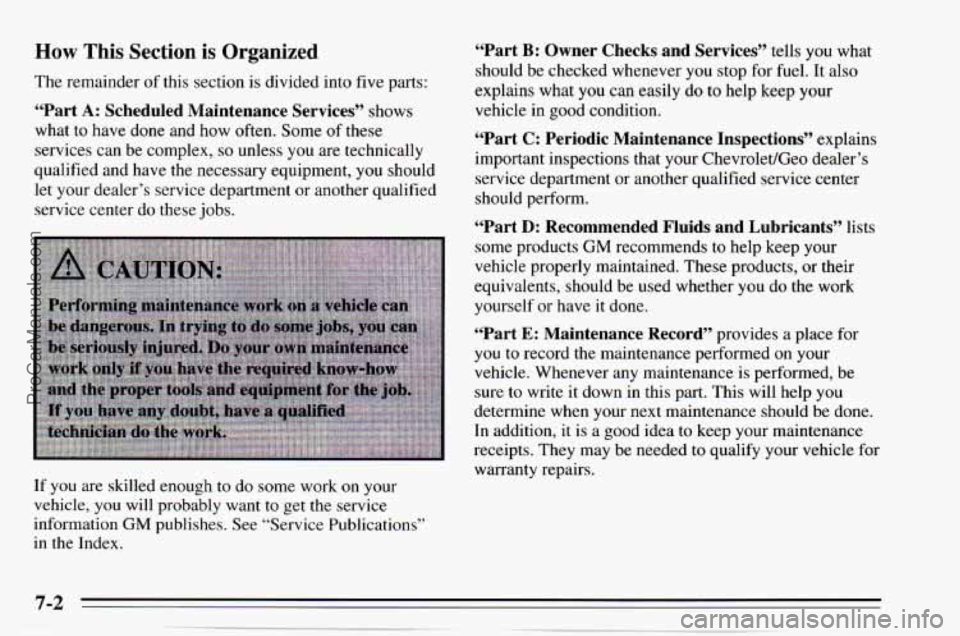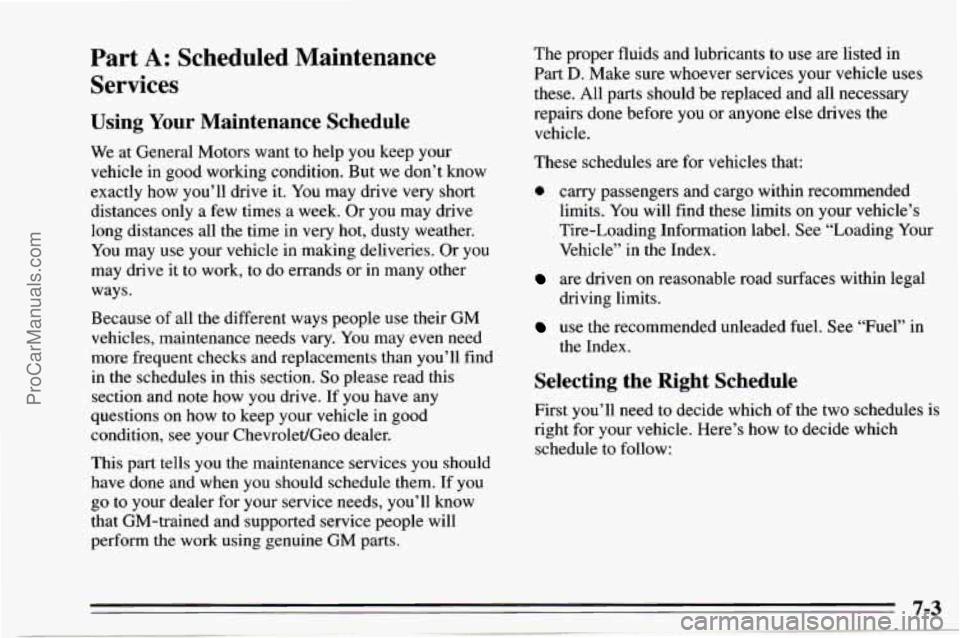Page 278 of 354

Gem Section 7 Maintenance Schedule
IMPORTANT:
KEEP ENGINE OIL
AT THE PROPER
RECOMMENDED
This section covers the maintenance required for your
Geo. Your vehicle needs these services to retain
its
safety, dependability and emission control performance.
Introduction
Your Vehicle and the Environment
Proper vehicle maintenance not only helps to keep your
vehicle
in good working condition, but also helps the
environment. All recommended maintenance procedures
are important. Improper vehicle maintenance or the
removal
of important components can significantly
affect the quality of the
air we breathe. Improper fluid
levels or even the wrong tire inflation can increase the
level of emissions from your vehicle.
To help protect our
environment, and to help keep your vehicle in good
condition, please maintain your vehicle properly.
Have you purchased the GM Protection Plan .? The Plan
supplements your new vehicle warranties. See your
Chevrolet/Geo dealersfor details.
7-1
ProCarManuals.com
Page 279 of 354

How This Section is Organized
The remainder of this section is divided into five parts:
“Part A: Scheduled Maintenance Services’’ shows
what
to have done and how often. Some of these
services can be complex,
so unless you are technically
qualified and have
the necessary equipment, you should
let your dealer’s service department or another qualified
service center do these jobs.
“Part B: Owner Checks and Services” tells you what
should be checked whenever
you stop for fuel. It also
explains what
you can easily do to help keep your
vehicle in good condition.
“Part C: Periodic Maintenance Inspections” explains
important inspections that your Chevrolet/Geo dealer’s
service department or another qualified service center
should perform.
“Part D: Recommended Fluids and Lubricants” lists
some products
GM recommends to help keep your
vehicle properly maintained. These products, or their
equivalents, should be used whether you do the work
yourself
or have it done.
“Part E: Maintenance Record” provides a place for
you to record the maintenance performed on your
vehicle. Whenever any maintenance is performed, be
sure to write it down in this part. This will help you
determine when your next maintenance should be done.
In addition, it is a good idea to keep your maintenance
receipts. They may be needed
to qualify your vehicle for
warranty repairs.
If you are skilled enough to do some work
on your
vehicle, you will probably want to get the service
information
GM publishes. See “Service Publications”
in the Index.
ProCarManuals.com
Page 280 of 354

Part A: Scheduled Maintenance
Services
Using Your Maintenance Schedule
We at General Motors want to help you keep your
vehicle in good working condition. But we don’t know
exactly how you’ll drive it.
You may drive very short
distances only a few times a week. Or you may drive
long distances all the time in very hot, dusty weather.
You may use your vehicle in making deliveries. Or you
may drive it to work, to do errands or
in many other
ways.
Because of all the different ways people use their
GM
vehicles, maintenance needs vary. You may even need
more frequent checks and replacements than you’ll find
in the schedules in this section. So please read this
section and note how you drive. If you have any
questions on how to keep your vehicle in good
condition, see your Chevrolet/Geo dealer.
This part tells you the maintenance services you should
have done and when you should schedule them.
If you
go to your dealer for your service needs, you’ll know
that GM-trained and supported service people will
perform the work using genuine
GM parts. The
proper fluids and lubricants
to use are listed in
Part
D. Make sure whoever services your vehicle uses
these. All parts should be replaced and all necessary
repairs done before
you or anyone else drives the
vehicle.
These schedules are
for vehicles that:
0 carry passengers and cargo within recommended
limits.
You will find these limits on your vehicle’s
Tire-Loading Information label. See “Loading Your
Vehicle’’ in the Index.
are driven on reasonable road surfaces within legal
driving limits.
use the recommended unleaded fuel. See “Fuel” in
the Index.
Selecting the Right Schedule
First you’ll need to decide which of the two schedules is
right for your vehicle. Here’s how to decide which schedule to follow:
ProCarManuals.com
Page 281 of 354

Maintenance Schedule
I Schedule I Definition
Follow Maintenance Schedule I if any one of these is
true for your vehicle:
Most trips are less than 5 to 10 miles (8 to 16 km).
This is particularly important when outside
temperatures are below freezing.
driving
in stop-and-go traffic).
Most trips include extensive idling (such as frequent
0 You frequently tow a trailer or use a carrier on top of
your vehicle.
Schedule
I should also be followed if the vehicle is used
for delivery service, police, taxi, or other commercial
application.
Schedule I Intervals
Every 3,000 Miles (5 000 km) or 3 Months,
Whichever Occurs First
Engine Oil and Filter Change
Free-Wheeling Hubs Inspection (If Equipped)
Every 6,000 Miles (10 000 km) or 6 Months,
Whichever Occurs First
Tire Rotation
Every 15,000 Miles (25 000 km)
Air Cleaner Filter Inspection, if driving in dusty
Front Wheel Bearing Repack (or at each brake
Manual Transmission Fluid Change (or every
Engine Idle Speed Check
Valve Lash (Clearance) Adjustment
Propeller Shafts and U-Joints Inspection (or every conditions
relining, whichever occurs first)
15 months, whichever occurs first)
15 months, whichever occurs first)
ProCarManuals.com
Page 282 of 354

Maintenance Schedule
Every 30,000 Miles (50 000 km)
Air Cleaner Filter Replacement
Spark Plug Replacement
Engine Accessory Drive Belt Inspection (or every
Fuel Filter Replacement (or every
30 months,
Cooling System Service (or every
30 months,
24 months, whichever occurs first)
whichever occurs first) whichever occurs first)
Every 50,000 Miles (83 000 lug)
Automatic Transmission Service (severe conditions
Positive Crankcase Ventilation
(PCV) Valve
Exhaust Gas Recirculation (EGR) System Inspection
only)
Replacement
Every 60,000 Miles (100 000 km)
Engine Timing and Distributor Check
Fuel Tank Cap Gasket Replacement
Emission System Hoses Inspection
Camshaft Timing Belt Replacement
Brake Fluid Service Spark Plug Wire Replacement (or every
60 months,
Wiring Harness and Connectors Inspection (or every
whichever
occurs first)
60 months, whichever occurs first)
Every 80,000 Miles (133 000 km)
Heated Oxygen Sensor Replacement
Every 90,000 Miles (150 000 km)
Camshaft Timing Belt Inspection
Every 100,000 Miles (166 000 km)
Fuel Injector Inspection
Evaporative Emissions Canister Replacement
Engine Control Module (ECM) and Associated
Sensors Inspection
7-5
ProCarManuals.com
Page 283 of 354
Maintenance Schedule
Schedule I1 Definition 'I
Follow Schedule I1 only if none of the conditions from
Schedule
I is true.
Schedule I1 Intervals
Every 7,500 Miles (12 500 km)
whichever occurs first)
every
3 months, whichever occurs first)
Engine
Oil and Filter Change (or every
7.5 months,
Free-Wheeling
Hubs Inspection (If Equipped) (or
Tire Rotation
Every 15,000 Miles (25 000 km)
Front Wheel Bearing Repack (or at each brake
relining)
Engine Idle Speed Check
Valve Lash (Clearance) Adjustment
Propeller Shafts and U-Joints Inspec :ti
15 months, whichever occurs first)
on (or every
7-6
I- ProCarManuals.com
Page 284 of 354

Maintenance Schedule
Every 30,000 Miles (50 000 km)
Engine Accessory Drive Belt Inspection (or every
24 months, whichever occurs first)
Cooling System Service (or every
30 months,
whichever occurs first)
Spark Plug Replacement
Air Cleaner Filter Replacement
Fuel Tank, Cap and Lines Inspection
Manual Transmission Fluid Change (or every
30 months, whichever occurs first)
Fuel Filter Replacement (or every
30 months,
whichever occurs first)
Every 50,000 Miles (83 000 km)
Automatic Transmission Service (severe conditions
Positive Crankcase Ventilation (PCV) Valve
Exhaust Gas Recirculation (EGR) System Inspection
only)
Replacement
Every 60,000 Miles (100 000 km)
Engine Timing and Distributor Check
Fuel Tank Cap Gasket Replacement
Emission System Hoses Inspection
Camshaft Timing Belt Replacement
Spark Plug Wire Replacement (or every
60 months,
Wiring Harness and Connectors Inspection (or every
Brake Fluid Service
whichever occurs first)
60 months, whichever
occurs first)
Every 90,000 Miles (150 000 km)
Camshaft Timing Belt Inspection
Every 100,000 Miles (166 000 km)
Fuel Injector Inspection
Evaporative Emissions Canister Replacement
Engine Control Module (ECM) and Associated
Sensors Inspection
ProCarManuals.com
Page 285 of 354
I Maintenance Schedule I I
The services shown in this schedule up to 100,000 miles
(166 000 km) should be performed after 100,000 miles
( 166 000 km) at the same intervals.
Footnotes
The U.S. Environmental Protection Agency or the
California Air Resources
Board has determined that the
failure
to perform this maintenance item will not nullify
the emission warranty or limit recall liability prior to the
completion
of vehicle useful life. We, however, urge that
all recommended maintenance services be performed at
the indicated intervals and the maintenance be recorded.
DATE
SERVICED BY: ACTUAL MILEAGE
3,000 Miles (5 000 km)
0 Change engine oil and filter (or every
3 months, whichever occurs first).
An Emission Control Service.
0 Inspect the locking front hubs (if equipped)
for correct operation (or every
3 months,
whichever occurs first). Repair or replace
if
necessary.
DATE ACTUAL MILEAGE
€
SERVICED BY
ProCarManuals.com